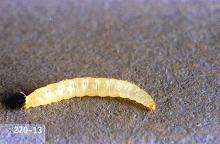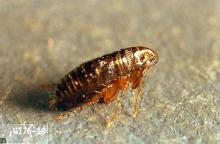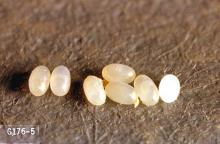Cat flea (Ctenocephalides felis)
Dog flea (Ctenocephalides canis)
Human flea (Pulex irritans)
Pest description and damage Fleas are the bane of every dog and cat - and their owners. Adult fleas are external parasites of warm-blooded animals. They bite people and pets. The bite often results in swelling and prolonged itching.
Adult fleas must get a blood meal to finish development. However, flea pupae (the stage before adults) can survive for long periods, waiting to detect the presence of a warm-blooded animal. This is why vacant premises can remain infested for an extended time. When pupae detect an animal, they complete development and emerge as adults that go in search of a blood meal.
Immature or larval fleas look like small white worms. They do not bite but instead feed on hair, shed skin, and dried blood in the animal's bedding or nest.
Management-flea control program
Flea collars do not have much effect against fleas, especially if the home is infested. Aerosol foggers or bombs have become a popular way for homeowners to dispense insecticides. However, these do a poor job of coverage. Essentially, they throw the insecticide into the air, thus treating only those exposed surfaces where the insecticide lands. Liquid formulations, carefully applied with some type of pressure applicator are a better choice, as they achieve much better coverage and might even be less expensive. Because fleas are nest parasites, outdoor insecticide treatments are unnecessary and of little value. Adult fleas do not survive for long away from their animal host.
Step 1
Vacuum rugs, drapes, and furniture thoroughly using a properly functioning vacuum cleaner and a fresh collector bag. Pay particular attention to areas where pets sleep. Discard or empty the bag outside because it contains fleas, flea larvae, and eggs that may re-infest the house. If appropriate, launder items in warm or hot soapy water.
Step 2
Treat rugs, furniture, and any outdoor sleeping areas (such as a dog house) with one of several flea sprays that contain an insect growth regulator insecticide as one of the active ingredients. Use these products according to label instructions.
A pesticide spray may contain other insecticides (often pyrethrin), but it must contain an insect growth regulator (IGR), such as s-methoprene, to be most effective. IGRs act by disrupting flea development: non-biting larvae never develop into adults and eventually die. IGRs are virtually nontoxic to humans and pets and are long-lasting, up to 7 months by some reports. IGRs act slowly, and for this reason, they frequently are combined with other, faster acting, insecticides which provide control of biting adult fleas.
Veterinarians are a good source of recommendations for appropriate pesticide products and have access to the latest flea control materials available. Flea "foggers" or "bombs" are ineffective and should not be used.
Step 3
Successful eradication of fleas is dependent on SIMULTANEOUS treatment of the pets and premises. Consult your veterinarian about products that are available to use on your pet. Shampoo your pet when dirty and use flea products when fleas are present.
Pet-applied and oral flea products
While these products can be effective, the three-step program outlined above still is recommended to rid the dwelling of fleas, and it is the least expensive approach. It is very important to read and follow the label directions on any flea product. Cats are especially sensitive to flea products. Using pesticide products not specifically labeled for cats can put their health at risk: fatalities have been reported. If a pet appears to have an adverse reaction to any product, contact a veterinarian immediately.
fipronil (Frontline)
imidacloprid (Advantage)
lufenuron and milbemycin oxime (Sentinel)
nitenpyram (Capstar).
For further information:
Flea and flea control. Oregon State University. https://entomology.oregonstate.edu/sites/agscid7/files/entomology/flea.pdfFleas: treatment and prevention. Oregon Veterinary Association. https://www.oregonvma.org/care-health/companion-animals/fleas




